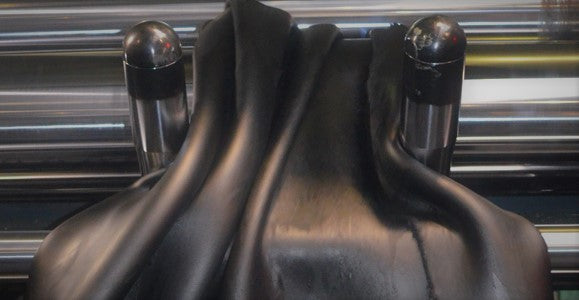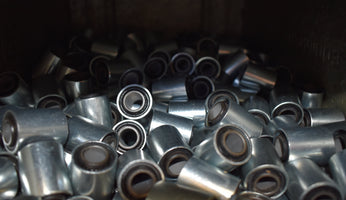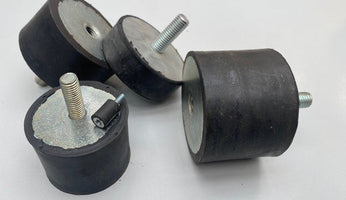Selecting a Rubber Compound

The below table is for use as a guide, and represents a highly simplified overview.
It is possible to improve rubber compounds performance in a particular area by using additives, for example, natural rubber’s oxidation, ozone & weather resistance properties can be improved significantly.
Rubber Properties
|
Common Name |
Natural |
SBR |
EPDM |
Butyl |
Neoprene |
Nitrile |
Viton* |
Therban |
|
Chemical Name |
Isoprene |
Styrene Butadiene Copolymer |
Ethelene Propylene & a Diene |
Isobutene – Isoprene |
Chloroprene |
Acrylonitrile Butadiene Copolymer |
Fluoronated Hydrocarbon |
Hydrogenated Acrylonitrile Butadiene |
|
Abbreviation |
NR |
SBR |
EPDM |
IIR |
CR |
NBR |
FKM |
HNBR |
|
Hardness range (°ShA) |
30 - 95 |
40 - 95 |
20 - 85 |
30 - 85 |
30 - 90 |
40 - 100 |
50 - 95 |
50 - 95 |
|
Colours |
Full range |
Full range |
Full range |
Limited range |
Limited range |
Limited range |
Limited range |
Full range |
|
Physical Strength |
Excellent |
Good |
Good |
Good |
Good |
Good |
Good |
Good |
|
Compression Set |
Good |
Good |
Good |
Good |
Fair |
Good |
Good |
Good |
|
Tear Resistance |
V. good |
Fair |
Good |
Good |
Good |
Good |
Good |
V. good |
|
Abrasion Resistance |
Excellent |
V. good |
Good |
Good |
Good |
Good |
Good |
V. good |
|
Bonding |
Good |
Good |
Fair |
Fair |
Good |
Good |
Good |
Good |
|
Resistance / Limts: |
||||||||
|
Continuous Heat |
75°C |
85°C |
130°C |
130°C |
95°C |
100°C |
205°C |
140°C |
|
Short term Heat |
105°C |
115°C |
150°C |
150°C |
125°C |
130°C |
260°C |
165°C |
|
Low temp |
-40°C |
-40°C |
-40°C |
-40°C |
-40°C |
-20°C |
-20°C |
-20°C |
|
Oxidation |
Fair |
Fair |
Excellent |
Excellent |
V. good |
Good |
Excellent |
Excellent |
|
Ozone & weather |
Poor |
Poor |
Outstanding |
Outstanding |
V. good |
Fair |
Excellent |
V. good |
|
Gas permeation |
Fair |
Fairly low |
Fairly low |
Excellent |
Low |
Low |
V. low |
Good |
|
Flame |
Poor |
Poor |
Poor |
Poor |
Self- Extinguishing |
Poor |
Self- Extinguishing |
Poor |
|
Water Absorption |
V. good |
Good |
Excellent |
Excellent |
Fair |
Good |
Good |
V. good |
|
Acids |
Fair |
Fair |
Good |
Good |
Good |
Good |
Excellent |
Good |
|
Bases |
Good |
Good |
Good |
Good |
Fair |
Fair |
Fair |
Good |
|
Alcohol @20°C |
Good |
Good |
Good |
Good |
Good |
Good |
Good |
Excellent |
|
Acetone @20°C |
Fair |
Fair |
Good |
Good |
Fair |
X |
X |
Good |
|
Benzene @20°C |
X |
X |
X |
X |
X |
X |
Good |
Fair |
|
Fuel: ASTM Fuel B @40°C |
X |
X |
X |
X |
Poor |
Fair |
Excellent |
Good |
|
Oil: ASTM Oil 1 @20°C |
Poor |
Poor |
Poor |
Poor |
Excellent |
Excellent |
Excellent |
Excellent |
|
@100°C |
X |
X |
X |
X |
Good |
Good |
Excellent (@150°C) |
Excellent |
|
Oil: ASTM Oil 3 @20°C |
X |
X |
X |
X |
Good |
Excellent |
Excellent |
Excellent |
|
@100°C |
X |
X |
X |
X |
Fair |
Good |
Excellent (@150°C) |
Excellent |
* Viton is a 'forever chemical' and contains PFAS.
X – Unsuitable or unsatisfactory performance
Note: the above data is provided as a general guide only. Mistakes might have been made in compiling this information. Customers must assure themselves that products are safe to use and perform as required under the relevant user scenarios.
It is important to select the correct base rubber compound to ensure the properties are in the correct area for the application. However, there are further aspects of the rubber which will impact performance.
Certain additives may be required to improve environmental resistance (e.g. ozone, weather), physical properties, or to improve temperature resistance. Other additives can improve tear resistance or help compounds meet fire retardant requirements, which are important for the rail industry.
AVMR have developed compounds which can withstand higher temperatures than standard ones, and we have a specific track pad compound with high abrasion and friction requirements.
The important point is that the table is a guide only.
Why not call us or send us your enquiry for a more detailed perspective.

